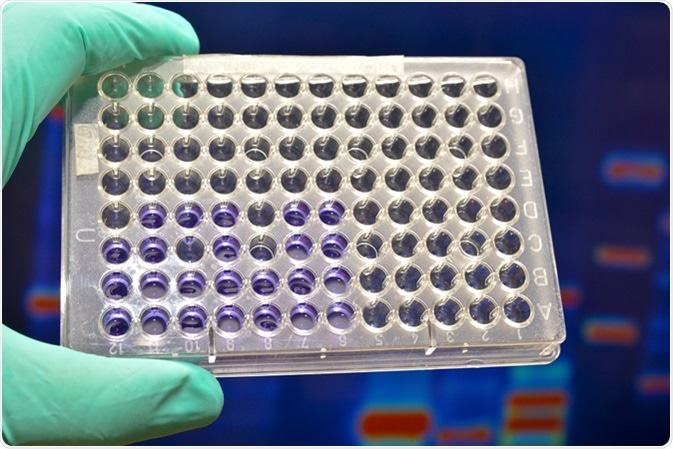Nucleic acids may be labeled at their 3’ end, 5’ end, or throughout the molecule, depending on the desired application. Myriad of enzymatic or chemical methods are utilized to generate nucleic acids labeled with enzymes, radioactive phosphates, or fluorophores.
For hybridization reactions (such as Southern or Northern blots), it is desirable to generate highly specific probes where the label is distributed throughout the nucleic acid. The techniques used are random priming, nick translation, as well as in vitro or polymerase chain reaction (PCR) transcription with labeled deoxynucleotide triphosphates (dNTPs) or nucleotide triphosphates (NTPs).
For applications that involve protein interactions (most notably gel-shift assays), it is advantageous to produce end-labeled probes in order to intercept steric interference.

Southern Blot, Northern Blot, and in situ Hybridization
Hybridization between immobilized nucleic acids and labeled probe allows for the detection of specific DNA/RNA sequences found in a complex mixture of nucleic acids. The specific method of detection (and subsequent visualization) is highly dependent on the nature of the probe that is labeled. More specifically, an enzyme-labeled probe enables colorimetric or chemiluminiscent detection, while radioactive probes facilitate autoradiographic detection.
Nucleic acid blotting may provide valuable information on the gene integrity and copy number (i.e. Southern blot), as well as a means of analyzing mRNA size and gene expression (i.e. Northern blot). Such methods can be employed for the purpose of characterizing cultured cells and tissues in vitro. These methods often yield important clinical information when used on patient samples.
The availability of different labels and a wide array of detection systems enhance the sensitivity and flexibility required for in situ hybridization. Current available options from various manufacturers also allow for simultaneous detection of multiple and differentially labeled probes within a single experiment.
Comparative Genomic Hybridization
Comparative genomic hybridization is based on fluorescence in situ hybridization and is employed for screening tumors and for detecting chromosomal imbalances. In this technique, labeled DNA samples from two sources are competitively hybridized onto the metaphase spreads of normal chromosomes. More specifically, one labeled DNA sample is isolated from the tumor tissue, and the other one is the differently labeled DNA from the normal tissue. Differential hybridization enables mapping of over-expressed or under-expressed chromosomal regions on normal chromosomes.
Biotin labeling is preferred as it is non-destructive. In this labeling technique, the original (larger) DNA fragments are labeled which allows for the analysis of DNA loss or gain from the tested tumor tissue sample. Over-represented chromosomal regions indicate tumor-promoting genes, whereas chromosomal deletions potentially indicate the presence of tumor-suppressing genes.
Cellular Localization
Biotin-labeled nucleic acids have been used with a lot of success for the study of intracellular trafficking of gene delivery complexes, as well as nuclear import mechanisms of nucleoprotein molecules found in viruses. Since these labeling systems do not tear down nucleic acid, nor create nascent ones, it is possible to tag and trace the original DNA or RNA throughout the experiment.
Moreover, there is a possibility for meticulous study of cellular interactions of gold-labeled plasmid DNA with various gene delivery vehicles and with cytoskeletal components of the cell, which can yield significant insights into gene delivery mechanisms.
These new directions in nucleic acid assay development will open the door for novel applications in human genetic disorders and their treatment.
Sources
- https://www.ncbi.nlm.nih.gov/pubmed/11928759
- http://clinchem.aaccjnls.org/content/45/4/453.long
- https://vectorlabs.com/media/docs/brochures/MBB.pdf
- https://link.springer.com/chapter/10.1385%2F1-59259-928-1%3A031
- currentprotocols.onlinelibrary.wiley.com/…/9780470089941.et0802s6
- www.seracare.com/…/…active-nucleic-acid-labeling-and-detection.pdf
Further Reading
- All Nucleic Acid Content
Last Updated: Feb 26, 2019

Written by
Dr. Tomislav Meštrović
Dr. Tomislav Meštrović is a medical doctor (MD) with a Ph.D. in biomedical and health sciences, specialist in the field of clinical microbiology, and an Assistant Professor at Croatia's youngest university – University North. In addition to his interest in clinical, research and lecturing activities, his immense passion for medical writing and scientific communication goes back to his student days. He enjoys contributing back to the community. In his spare time, Tomislav is a movie buff and an avid traveler.
Source: Read Full Article
